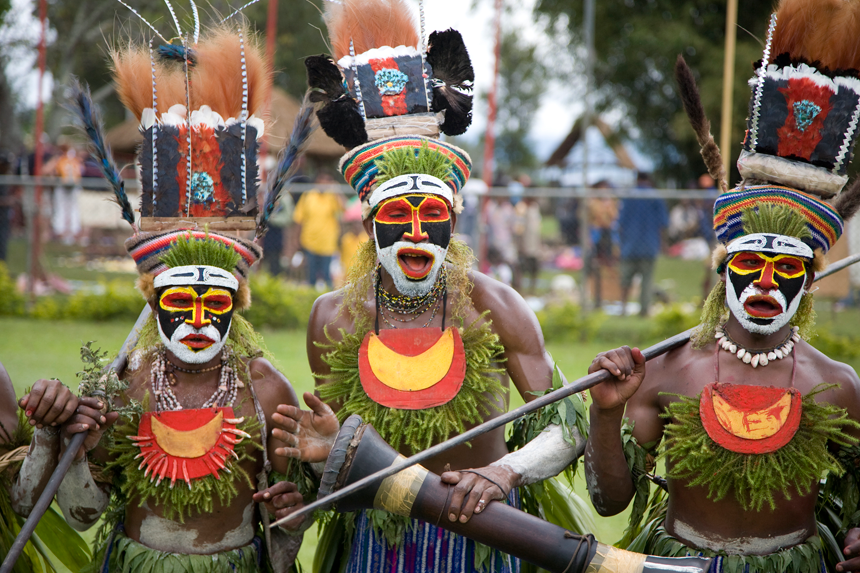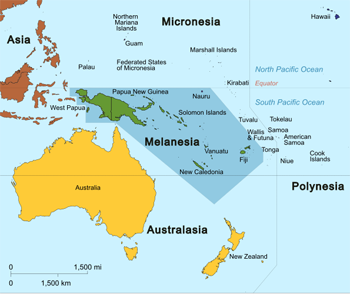Human DNA carries hints of unknown extinct ancestor
New analyses suggest ancestors of modern Pacific Islanders bred with an extinct species still unknown to science

These men live in Papua New Guinea, one of four nations making up Melanesia. Some people from their region appear to carry remnant genes from an unknown ancestral species.
Anselmo Lastra/ Flickr CC BY 2.0
VANCOUVER, British Columbia — The human family tree may be even more tangled than scientists had thought. A new computer analysis has turned up evidence pointing to some long-lost human cousins. That evidence was found hiding in the DNA — genetic instruction book — of some people alive today.
Ryan Bohlender led the new study. This statistical geneticist works at the University of Texas MD Anderson Cancer Center in Houston. He and his colleagues pored over DNA from people living in Melanesia. This part of the South Pacific includes Papua New Guinea and nearby islands. And here, the new study finds, people inherited genes that appear to come from an unknown extinct hominid. (Hominids are a group of species that includes humans and our ancient relatives.)

Bohlender reported his team’s new conclusions here in Canada, on October 20. It was at the annual meeting of the American Society of Human Genetics.
Earlier research had shown that the ancestors of Melanesians mated with two groups of extinct hominids. One group, Neandertals, left behind fossils in Europe and Asia. The other group had been distant cousins of the Neandertals. Known as Denisovans (Deh-NEES-oh-vuns), this group is known only from DNA found in a finger bone and a couple of teeth. Their fossils came from a cave in Siberia.
The new study found some mysterious DNA in Melanesians that was very old. But it didn’t seem to come from either Neandertals or Denisovans. The mystery DNA likely comes from a third hominid species. Scientists have not yet found fossil evidence for such a species, Bohlender notes.
Other scientists also have dug into the DNA of present-day people and found traces of unknown species. In 2012, another group of researchers suggested some Africans carry heirloom DNA from an unknown extinct hominid. Again, no bones with that particular DNA have yet turned up.
Accounting for missing DNA
After ancestors of humans began migrating out of Africa, they mixed with Neandertals in Europe and Asia. As a result, people whose ancestors came from outside of Africa still carry a small amount of Neandertal DNA. Bohlender and his colleagues calculate that Europeans and Chinese people carry a similar amount of this Neandertal ancestry — some 2.8 percent.
Europeans have no sign of Denisovan ancestry. People in China do, but the amount is very small, just 0.1 percent, according to calculations by Bohlender’s group. But 2.74 percent of the DNA in people in Papua New Guinea comes from Neandertals. And Bohlender estimates the Denisovan DNA in Melanesians at about 1.1 percent. That’s far less than the 3 to 6 percent Denisovan DNA that other researchers have reported in the Melanesians.

But Melanesians carry other bits of old DNA too. These bits may have come from a relative of Neandertals and Denisovans. If true, that would make a third species of extinct hominid that has mixed with human ancestors.
“Human history is a lot more complicated than we thought it was,” Bohlender now says.
Another team recently concluded much the same thing. Eske Willerslev, who led this group, is an evolutionary geneticist. He works at the Natural History Museum of Denmark in Copenhagen. Willerslev’s group examined DNA from 83 aboriginal Australians. They also probed the DNA of 25 people from native populations in Papua New Guinea. DNA similar to Denisovans showed up in the study volunteers. But that DNA didn’t match that of the Denisovans precisely. In fact, it may be from another extinct hominid. That’s what these researchers reported in the October 13 Nature. “Who this group is we don’t know,” Willerslev points out.
Fossils from other extinct human relatives have been found in the South Pacific. Scientists have not yet gotten DNA out of those bones. It’s possible that the not-quite-Denisovan DNA that Willerslev’s team found comes from one those unknown hominids. If researchers can get DNA from the old bones, they’ll try to match it to what’s in people today.
A possible confounder
It’s hard to know for sure whether such a third group mated with the ancestors of the South Pacific islanders. One reason is that within any group, DNA will vary from person to person. Some groups have quite a bit of this genetic diversity.
Researchers don’t know much about Denisovans, says Mattias Jakobsson. He’s an evolutionary geneticist at Uppsala University in Sweden. But it’s possible that Denisovans formed distant communities. These might have been separated from each other for a long time. If true, those groups could have developed many genetic differences. If there were enough such changes to their DNA, this might have fooled scientists into thinking the groups were different species.
Still, Jakobsson says he wouldn’t be surprised if other groups of extinct hominids mixed with humans. Modern and ancient humans, he observes, “have met many times and had many children together.”







